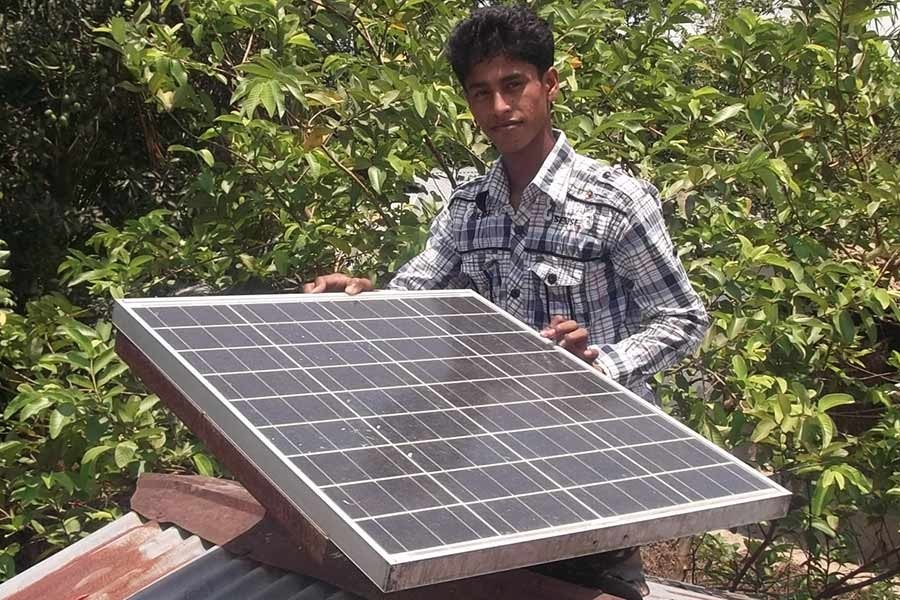
Published :
Updated :

Until recently, solar power has mainly been an off-grid power generation source, particularly in places where grid connectivity was not available. But lately, power added to the national grid by solar plants has brought the prospect of quickly raising the share of solar energy as well as increasing grid capacity. It got reported that a 35mw solar power plant under Bangla-China joint venture at Shibalaya, Manikganj, has already started supplying electricity to the national grid. The state-owned Bangladesh Power Development Board (BPDB) will purchase electricity from this independent power producer (IPP) under a 20-year power purchase agreement (PPA). Earlier, four IPP projects - 50MW (AC) Solar Park Gauripur, Mymensingh, 8MW Solar Park in Panchagarh, 20MW (AC) Solar Park in Teknaf, Cox's Bazar, and 3MW Grid-connected PV Power Plant at Sharishabari in Jamalpur - went into operation.
Very recently, an agreement has been inked between the state-owned Electricity Generation Company of Bangladesh Limited (EGCB) and Marubeni Corporation of Japan for implementing a 100MW solar power plant at Sonagazi in Feni.
These, no doubt, are mentionable steps to increase power generation - that too through raising the share of renewable energy in the country's power generation. The country's Power System Master PLan (PSMP) has set a target to reach renewable energy's share to 10 per cent of total power generation capacity (2470MW) by the current year. The major focus is obviously on exploiting the potential of solar energy to achieve the goal. However, available data show the country now has a generation capacity of 20,595MW from conventional sources while power from renewable sources is lagging far behind at 700.61MW - around 3.0 per cent of the total generation capacity.
So, reaching the target is quite unlikely to happen in the period meant to achieve so. Energy experts, however, say that although reaching the target is not likely to materialise in the pandemic time, the country would scale up renewable energy production manifold in the near future, given that there is already an organised move to set up plants, particularly solar plants, and the government too is committed to encouraging such ventures.
It may be noted that an organisation named International Solar Alliance (ISA) has been set up last year aimed at building a network to help tropical countries boost their use of solar power. A well-taken initiative, this is going to help many countries to meet their grid power deficit through increased application of solar devices for meeting mounting home and industrial demands. As for Bangladesh, one of the lead countries to make the best of solar energy, especially through rooftop solar power, it can benefit immensely from the ISA initiative in applying innovative devices at affordable cost.
As regards solar home system (SHS), it is pretty well known that Bangladesh is already a big name, and is acclaimed as the largest off-grid renewable energy programme in the world. According to a report of the Paris-based energy think-tank REN21, as of 2018, more than 6.0 million SHS and kits were in operation worldwide, with 25 million people benefiting from them. Bangladesh, the largest SHS market worldwide, has more than 4.0 million units installed.
This indeed is laudable. Infrastructure Development Company Ltd (IDCOL) Bangladesh, the focal point in this regard, commenced its SHS programme in early 2003 to meet basic electricity needs of the off-grid rural people as well as to supplement the government's vision of ensuring access to electricity for all citizens by 2021. As per latest data, 4.6 million SHSs were installed under the programme in the remote areas where electrification through gird expansion is challenging and costly. This way, the programme ensured supply of solar electricity to 21 million people i.e., more than 12 per cent of the country's total population who previously used kerosene lamps for lighting purpose. IDCOL has a target to finance 6.0 million SHS by 2021 with an estimated generation capacity of 220 MW of electricity.
The multi-donor funded programme has proved highly beneficial, especially in the far-flung off-grid locations, including among others the char areas where grid connectivity is too remote a dream for the people. As per the energy and power ministry data, currently, 2.86 per cent of all power generated in the country comes from renewable energy, including solar power.
The government has set a target to generate 2,000 MW of electricity from renewable energy by 2021, of which more than 1,600MW will be produced from solar energy. It is estimated that more than 400MW of electricity can be produced from the textile industries' rooftops and there is a potential of producing about 4,000MW of electricity from industrial and commercial rooftops. IDCOL has 30 solar rooftop projects in its pipeline with a cumulative capacity of 30MW and it intends to finance solar rooftop projects to generate 1,000MW.
With the momentum on, SHS is highly likely to reach out to increasing number of the population in the near future. Currently, the country has around 38 per cent of the population without access to electricity. With grid connectivity growing as a result of the newly installed power stations, a sizeable population in remote areas will still remain off-grid. This is where SHS are to fill in the gap.
So what is particularly mentionable here is that solar power has proved to offer a very prospective mix of off-grid and on-grid energy that will benefit the country immensely. In this connection, it may not be out of place to flag the importance of proactive government policy regarding this energy mix.
wasiahmed.bd@gmail.com


 For all latest news, follow The Financial Express Google News channel.
For all latest news, follow The Financial Express Google News channel.